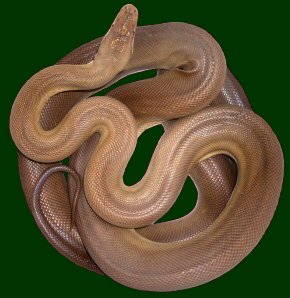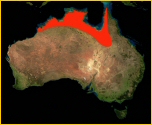
![]()
Description
 This is one of the largest Australian python taxons. Typical adult size for Liasis olivaceous is 8-10ft with some specimens achieving lengths of 11-12ft. Despite its length the olive python is a relatively slender species, never achieving the body mass of other python taxa of similar length.
This is one of the largest Australian python taxons. Typical adult size for Liasis olivaceous is 8-10ft with some specimens achieving lengths of 11-12ft. Despite its length the olive python is a relatively slender species, never achieving the body mass of other python taxa of similar length.
 Olive pythons are patternless with all specimens ranging from brown to olive in coloration. The chin and ventral surface is a pale cream or ivory color. This species is nearly unique among pythons in being truly patternless, only the closely related Liasis fuscus shares this characteristic.
Olive pythons are patternless with all specimens ranging from brown to olive in coloration. The chin and ventral surface is a pale cream or ivory color. This species is nearly unique among pythons in being truly patternless, only the closely related Liasis fuscus shares this characteristic.
Habitat
CARANBIRINI CONSERVATION RESERVE NT_thm.jpg) Olive pythons occupy a variety of habitats within their range and they are often associated with the various permanent and seasonal water sources within coastal northern Australia. Olive pythons are considered to be a primarily terrestrial, though they are good climbers making use of fractured rock escarpments and other rock formations. These pythons can also be found in areas of seasonally wet forest and savannah.
Olive pythons occupy a variety of habitats within their range and they are often associated with the various permanent and seasonal water sources within coastal northern Australia. Olive pythons are considered to be a primarily terrestrial, though they are good climbers making use of fractured rock escarpments and other rock formations. These pythons can also be found in areas of seasonally wet forest and savannah.
Distribution
 Olive pythons range throughout most of northern Australia, from the Kimberly region in the west to the western side of the Cape York Peninsula. The Great Dividing Range serves as a natural barrier and as such olive pythons are absent from the eastern coast.
Olive pythons range throughout most of northern Australia, from the Kimberly region in the west to the western side of the Cape York Peninsula. The Great Dividing Range serves as a natural barrier and as such olive pythons are absent from the eastern coast.
Projects
I have been working with this species for over a decade and have enjoyed consistent breeding success in the last several years. Olive pythons are still quite rare in US collections. Hopefully the continued successful breeding of this species will allow more people to enjoy them in the coming years.
